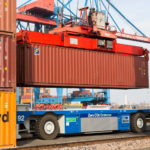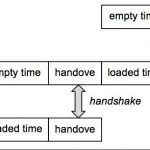Since the opening of the world’s first automated container terminal in Rotterdam in 1993, more and more have been built. They promise to achieve high productivities at reduced costs. Naturally, terminal operators aim at further increasing the productivity during the operational phase as well
The heart of an automated container terminal is the stack with automated cranes and the automated transport[ds_preview] between quay and stack, in most cases done by automated guided vehicles (AGVs). Recent years have brought various improvements and new technologies for the handling equipment. Examples include two or even three stacking cranes for a yard block as well as lift AGVs. The latter are able to put a container on a rack at a yard block such that they do not have to wait for the stacking crane to take the container. Further examples are automated straddle or shuttle carriers, remote-controlled quay cranes
as well as twin lift and tandem lift quay cranes.
Terminal operating system
If the stacking cranes and the vehicles are the heart of an automated container terminal, then the terminal operating system (TOS) is the brain. The TOS is the software that controls all the processes on the terminal. It decides which crane and which vehicle will handle which container at what time and where a container is stacked. Thereby the TOS influences how long it takes a stacking crane or vehicle to get to the location where a container is to be picked up (»empty time«) and how long it takes to transport it to the destination (»loaded time«). The TOS also has an impact on the so-called handshake: A vehicle and a crane have to meet just in time for handing over a container – otherwise, one of them has to wait.
Finally, the TOS influences the need for time-consuming (but non-productive) shuffle moves of stacking cranes. To put it in a nutshell: The TOS has a major impact on productivity.
Therefore, the minimization of the empty and loaded driving times and the synchronization of the container handover are among the main objectives of the TOS. If this is achieved, the resources can handle more containers per hour which increases the productivity, and quay cranes are less likely to wait, which reduces vessel service times (as well as truck service times on the landside). All decisions made by the TOS are determined by special algorithms. While more advanced methods often lead to better results in terms of productivity and punctuality, developing them also requires more time and special know-how. An additional requirement is that decisions by the TOS have to be made in real time – thus, the algorithms have to be extremely fast.
Optimizing the processes
The last two decades not only brought new and improved handling equipment. Terminal operators have also conducted various studies concerning the TOS. The goal of many studies was to develop new algorithms which help to improve the productivity. Three studies provide new insights and improved algorithms for the TOS.
In 2011 Ulf Speer, Gerlinde John and and Kathrin Fischer developed an advanced algorithm to optimize the rail-mounted gantry cranes in the stack. The method evaluates a large number of possible orders of the upcoming transportation tasks and of different assignments of transportation orders to cranes in a very efficient way. Moreover, it considers expected crane interference. This way, the best possible crane schedule is determined.
Five years earlier, Dirk Briskorn, Andreas Drexel and Sönke Hartmann looked at the assignment of AGVs to transportation tasks. They analyzed both the advantage of advanced algorithms over simple heuristic methods and the impact of uncertain data of future tasks. By reducing the level of uncertainty in the calculation, the handshake of AGVs and quay cranes can be improved.
In 2008 Ewgenij Gawrilow, Ekkehard Köhler, Rolf H. Möhring and Björn Stenzel tackled a different part of the AGV system. In conventional systems, AGVs are assigned the shortest possible route to their destination, but they might be slowed down on their way by interference with other AGVs and even temporary congestion. The experts developed an ambitious routing method that takes into account the future movements of all other AGVs over time when calculating the route for an AGV. This way, congestions are avoided already when a route is calculated and shorter driving times are achieved.
These studies have three aspects in common. First, they show that more advanced methods lead to higher terminal productivities than simple approaches. Second, they take the availability and the quality of the data into account – a method is only as good as the data it calculates with. Third, they all employ simulation models to test and compare methods in a realistic environment.
Studies like the ones mentioned above require highly specialized knowledge. Therefore, terminals often collaborate with universities, research institutes or consultants that have experience with automated container handling as well as in-depth knowledge of optimization methods and simulation models.
Conclusion
New equipment technologies for automated container terminals are not only fascinating, they also play a key role in improving productivities and reducing costs. Nevertheless, an efficient terminal operating system (TOS) is at least as important. Research studies on algorithms for the TOS can help to improve productivities substantially, and software improvements typically come at less costs than additional equipment. A future paper will showcase how simulation technology and virtual terminals are supporting the development and fine-tuning of the advanced algorithms described in this contribution.
Authors: Sönke Hartmann,
HSBA Hamburg School of Business Administration, soenke.hartmann@hsba.de
Holger Schütt, ISL Applications GmbH, Bremen
Sönke Hartmann, Holger Schütt




















